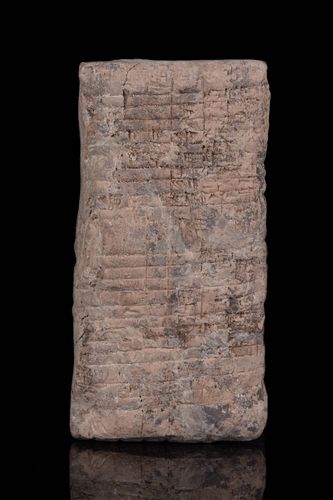AN OLD BABYLONIAN CUNEIFORM ADMINISTRATIVE TABLET
Lot 336
Estimate:
GBP£2,000 - GBP£4,000
$2,564.10 - $5,128.21
Absentee vs Live bid
Two ways to bid:
- Leave a max absentee bid and the platform will bid on your behalf up to your maximum bid during the live auction.
- Bid live during the auction and your bids will be submitted real-time to the auctioneer.
Bid Increments
| Price | Bid Increment |
|---|---|
| GBP£0 | GBP£10 |
| GBP£100 | GBP£10 |
| GBP£200 | GBP£20 |
| GBP£500 | GBP£50 |
| GBP£1,000 | GBP£100 |
| GBP£2,000 | GBP£200 |
| GBP£5,000 | GBP£500 |
| GBP£10,000 | GBP£1,000 |
| GBP£20,000 | GBP£2,000 |
| GBP£50,000 | GBP£5,000 |
| GBP£100,000 | GBP£10,000 |
| GBP£200,000 | GBP£20,000 |
| GBP£1,000,000 | GBP£50,000 |
About Auction
By Apollo Art Auctions
Jan 16, 2022
Set Reminder
2022-01-16 08:00:00
2022-01-16 08:00:00
America/New_York
Bidsquare
Bidsquare : Ancient Art & Antiquities
https://www.bidsquare.com/auctions/apollo-art-auctions/ancient-art-antiquities-8043
Apollo Art Auctions enquiries@apolloauctions.com
Apollo Art Auctions enquiries@apolloauctions.com
- Lot Description
Circa 1900 BC A large rectangular Babylonian clay cuneiform tablet with four columns of figures and names of men in each line. Size: 113 x 57mm. Fine condition. With a G. Lambert signed descriptive note. Clay cuneiform tablets were small enough to be portable and durable when dried, clay tablets allowed for the transmission of information across time and space. Although different types of scrips and languages could be impressed into the clay using a reed stylus. This method of writing was most often used to create texts in the cuneiform script and Akkadian language. For reading: E. Sollberger, 'New Lists of the Kings of Ur and Isin', Journal of Cuneiform Studies 8, 1954, pp.135-6. A.H. Grayson, King List 2, 'K?niglisten und Chroniken' Reallexicon der Assyriologie und vorderasiatische Archaeologie, Berlin, 1980, p. 90. K Lippincott (ed.), with Umberto Eco & E.H. Gombrich, The Story of Time, London, 1999, p.255. J Friberg, A Remarkable Collection of Babylonian Mathematical Texts (Sources and Studies in the History of Mathematics and Physical Sciences. Manuscripts in the Sch?yen Collection: Cuneiform Texts I), New York, 2007, pp.233-236. Andrew George (ed.), Cuneiform Royal Inscriptions and Related Texts in the Sch?yen Collection (Cornell University Studies in Assyriology and Sumerology, vol. 17, Manuscripts in the Sch?yen Collection, Cuneiform texts VI), Bethesda, 2011, text 100, pp.206-207, pl. LXXXV. Size: L:112mm / W:57mm ; 255g. Provenance: From the important collection of a London doctor A.R; passed by descent to his son; formerly acquired between 1970-2000. Big parts of the collection were studied/published by Professor Lambert in the early 1990s.
- Shipping Info
-
We offer in-house packing and international shipping at discounted rates.
-
- Buyer's Premium



 EUR
EUR CAD
CAD AUD
AUD GBP
GBP MXN
MXN HKD
HKD CNY
CNY MYR
MYR SEK
SEK SGD
SGD CHF
CHF THB
THB
















